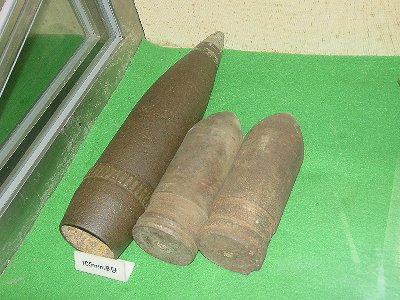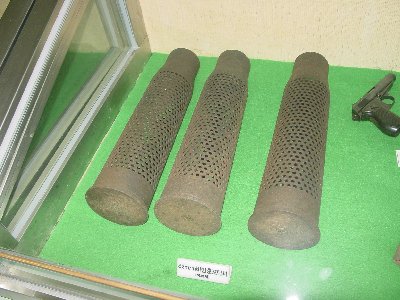
Chorwon Museum
These are items on display at the museum next to the Chulwon Spa Hotel, which I assume is in the rebuilt Chorwon.

These are 105mm projectiles.
A Jack Rose has written me that on the left is a high explosive round due to its pointed shape and fuse. The other two are anti-tank projectiles due to their shape, and probably had thin nose cone when fired to reduce wind resistance. The spot in the center of the base is to release the tracer element which helped in aiming later rounds. Usually the AT round is fired from a high velocity weapon, and since most or all UN 105 rounds were for howitzers, these are probably communist projectiles.

The English description given is "82mm".
Mr. Rose has added,
"The two shell cases with all the holes are shell cases for a recoilless piece. I would guess from the looks that they are for a 75mm recoilless. They are labeled 82mm which is probably wrong. The only 82 mm I know of in the enemy arsenal was the 82 mm mortar. The perforations in the shell casings were to let the expanding gasses vent to the rear.
The open rear end that pieces called throat blocks which could be changed to regulate the gas going to the rear. If too little gas went to the rear the rifle would recoil, if too much gas went to the rear the rifle would move forward toward the target. A rather impressive demonstration was to hang the piece on two wires and fire it. If properly adjusted there would be no movement of the piece.
The projectile had rotating bands but unlike conventional artillery, the rotating bands had grooves that fit the rifling. In ordinary artillery the grooves are cut into the bands as the projectile is fired. The rotating bands act as a seal to prevent gasses from escaping. Incidentally, the propellant was enclosed in a plastic bag inside the shell casing to prevent loss of propellant."
A Kevin Larabee provided some information on 82 mm recoilless rifle. Based on a World War II German weapon, the Pupchen, the Soviet 82 mm anti-tank rifle has also been used in Vietnam and Afghanistan, but has been generally replaced by rocket propelled grenades. At least one model had a small rifle, whose fire was used to help aim the 82 mm round.